Backpacking has been a great love of mine since childhood.
As a child, my mother used to hike along the Dewdney trail to visit a family friend and gold prospector, Ed Jordan. He had a cabin in the mountains outside of Creston, BC, and her family was very close to him. Ed Jordan would take mom and her brother up to spend time up in the cabin. She passed this love and respect of the wilderness onto her children. My sister Jo and I made our first “solo” hike when we were about ages 11 and 13. We made our menu, packed our food, and planned our route along the miles of dikes in the Creston Valley flats.
The passion to sleep in a tent and wake up to the sunrise never left us. We longed for the opportunity to live on the trail as explorers like Lewis and Clark had done. In fact, while we hiked along the Continental Divide Trail, we followed parts of the Lewis and Clark trail, the Mormon Trail, and the Pony Express.
Yoga on the Trail
Continuing on from part 1, let’s look now at more ways to support the body while it endures months of life on the trail. This section will focus on chest openers. I realise I am a bit of a backbend junkie, and that these are images of my intensely deep backbends. If you practice yoga, then default to your own level of expertise and enjoy the degree of flexibility you have. My intention was to ensure I didn’t lose my flexibility while I travelled on the trail, carrying my life with me internally and externally.

Mugs on the trail in Bhujangasana, the Cobra Pose.

Bhujangasana (cobra) and Ustrasana (camel) give a variety of angles to stretch out the shoulders, neck, arms and spine. These are great chest openers to facilitate deep breathing and counter the rounding of shoulders from carrying a heavy backpack.
I don’t recommend everyone drop the neck back as shown in this image. I did this to really get the front of my neck stretched because it gathers a lot of tension from leaning forward when hiking with a heavy backpack. I took great care to lengthen the cervical muscles and spine to elongate the neck as much as possible before lowering it back. Then there was space for the vertebrae in the back of the neck. I recommend in both these poses you keep the neck upright and focus on opening the chest by lifting the sternum. This will open the thoracic spine and continue to strengthen the back.
Dhanurasana (bow pose) helps to relieve the congestion in the shoulders and arms. Start with Ardha-Dhanurasana, the half-bow. If you cannot reach the ankle, then wrap your belt around the ankle and grab the belt.

Ardha (half) and Poorna (full) Dhanurasana are both great chest openers, stretching the pectorals and biceps. Additionally, the hip flexors, abdominals and quadriceps get a good stretch. These variations provide a counter-effect for the back that has carried the weight of the backpack.
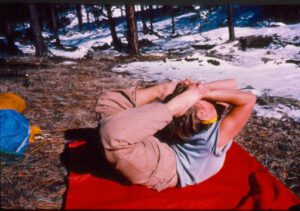
Chakrasana (wheel pose) feels good to the shoulders and abdomen after slouching forward. It stretches the deltoids in the shoulder area, the hip flexors, quadriceps and the abdominals. It strengthens the back and the wrists. The arms tire from picking up and setting down the pack numerous times throughout the day.
This pose is named Chakrasana because it works the entire length of the spine, and therefore all the chakras in the subtle body. It is such a backbend stretch that it actually becomes an inversion, where the head is lower than the heart.
Poorna Supta Vajrasana (Full supine thunderbolt or Diamond pose) is another intense backbend that opens the chest, stretches out the hip flexors and abdominals, strengthens the back muscles, lengthens the quadriceps and provides a great extension to the triceps.
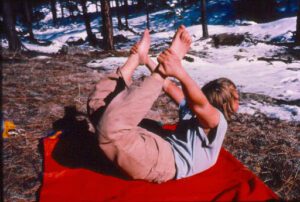

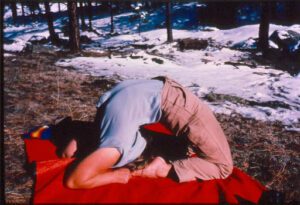
Poorna Supta Vajrasana, the Full Reclined Thunderbolt pose.
All of these strong back stretches, including the Poorna Shalabhasana (full locust) build strength and maintain flexibility. They open the chest and strengthen the back.
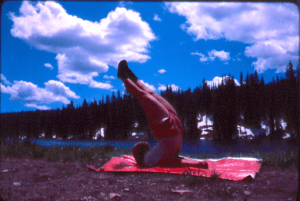
Poorna Shalabhasana, the Full Locust pose.
Let’s look at one more aspect of opening the chest. Side bends stretch the intercostal muscles which connect to the ribs and help us to inhale and exhale. They provide a lateral stretch to the spine, which is often neglected in our day-to-day movement. These side bends strengthen the oblique muscles, stretch the latissimus dorsi and the erector spinae. Additionally, they provide balance and improve posture.
Trikonasana (triangle pose) and Nitambhasana (palm tree or fountain pose) are done standing. Parighasana (gate pose) is done kneeling, and Supta Nitambhasana is done lying down.
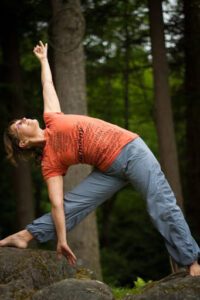
Trikonasana in the forest.
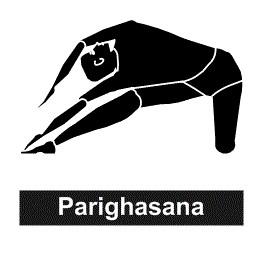
Parighasana, the Gate Pose, is on the knees.
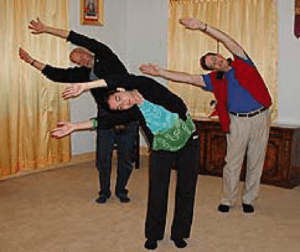
Nitambasana is a great lateral stretch to the spine
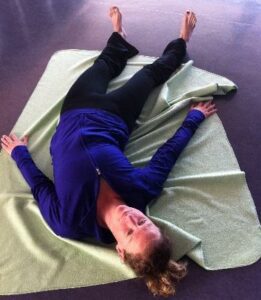
Supta Nitambhasana is lying down on the back
Yoga Asanas will keep you going on the trail!
Bhujangasana (cobra), Dhanurasana (bow), Poorna supta vajrasana (diamond), Ustrasana (camel), Parighasana (gate) and Supta Nitambhasana (supine palm tree) are all adaptable to do inside the tent because they are on your knees or lying down.
All of these chest opening poses make backpacking more comfortable while taxing the body to the max. It is no easy task to get up every morning, load up your tent and gear, food and water, and walk 20+ kms day in and day out, rain, snow or shine. But it is an experience of tremendous growth and discovery in what one can and cannot do. If yoga can make it an easier journey (and it did on so many levels), then why not let yoga do it’s magic?
To be continued….. Part 3 will be asanas for the arms and legs.
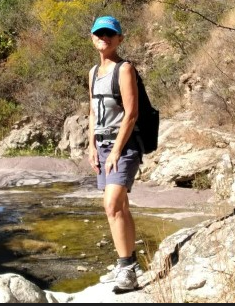
Marion Mugs McConnell is the co-founder of SOYA and the SOYA Yoga Teacher Training program. She is an avid backpacker, hiker, and yoga student. She is the author of Letters from the Yoga Masters: Teachings Revealed through Correspondence from Paramhansa Yogananda, Ramana Maharshi, Swami Sivananda, and Others, published by North Atlantic Books copyright © 2016 ISBN 978-1-62317-035-6.

Recent Comments